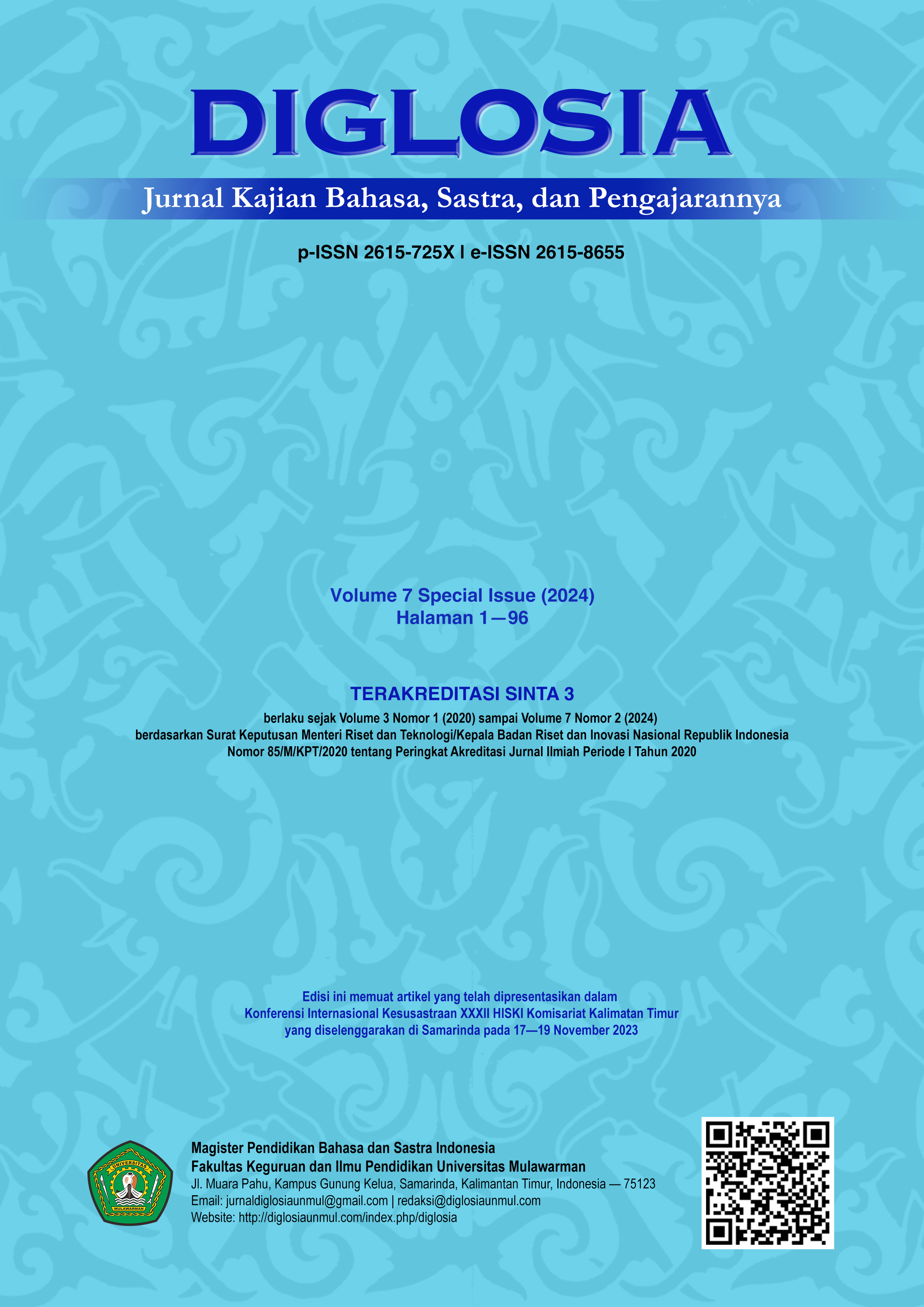Etnis Cina pada novel Di Kaki Bukit Cibalak karya Ahmad Tohari: representasi gagasan tentang keselarasan hidup Ethnic Chinese in the novel Di Kaki Bukit Cibalak by Ahmad Tohari: a representation of the idea of harmony of life
Main Article Content
Abstract
The purpose this article is to obtain a representation of the idea of Chinese ethnic assimilation as a form of life harmony in the novel Di Kaki Bukit Cibalak (DKBC) based on the author's worldview. This article is qualitative research with descriptive analysis and a literary sociology approach based on Goldmann's genetic structuralism theory, Lotman's semiotics, and Mukařovskŷ backpack's literary aesthetics. In addition to finding the author's worldview, the text of DKBC is also seen as a dynamic aesthetic object. The primary data source is the novel DKBC by Ahmad Tohari; the secondary data source is articles and some reference literature related to diversity and harmonization. The stages of analysis were carried out using the first-level semiotic reading (heuristic) and continued with the second-level semiotic reading (hermeneutic). The results show an effort to build diversity and harmonization through blending, leading to life harmony. The emergence of Mulyani's perspective, which is different from her mother's in the novel DKBC, represents the complex and heterogeneous side of human life. The assimilation of ethnic Chinese is an important message about diversity and heterogeneity in Ahmad Tohari's novels. In such a context, the harmony of life represents ideas that the author voices well.
Downloads
Article Details
![]()
Every work in Diglosia: Jurnal Kajian Bahasa, Sastra, dan Pengajarannya is licensed under a Creative Commons Attribution-ShareAlike 4.0 International License.
Under the following terms:
- Attribution — You must give appropriate credit , provide a link to the license, and indicate if changes were made . You may do so in any reasonable manner, but not in any way that suggests the licensor endorses you or your use.
- ShareAlike — If you remix, transform, or build upon the material, you must distribute your contributions under the same license as the original.
- No additional restrictions — You may not apply legal terms or technological measures that legally restrict others from doing anything the license permits.
Authors who publish with this journal agree to the following terms:
- Authors retain copyright and grant the journal right of first publication with the work simultaneously licensed under a CC BY-SA 4.0 DEED Attribution-ShareAlike 4.0 Internationalthat allows others to share the work with an acknowledgment of the work's authorship and initial publication in this journal.
- Authors are able to enter into separate, additional contractual arrangements for the non-exclusive distribution of the journal's published version of the work (e.g., post it to an institutional repository or publish it in a book), with an acknowledgment of its initial publication in this journal.
- Authors are permitted and encouraged to post their work online (e.g., in institutional repositories or on their website) prior to and during the submission process, as it can lead to productive exchanges, as well as earlier and greater citation of published work.
References
Faruk. (2017). Pengantar Sosiologi Sastra: Dari Strukturalisme Genetik sampai Post Modernisme (Edisi Revisi). Pustaka Pelajar.
Gani, E., & Marizal, Y. (2023). Ketidakadilan Gender Novel Azab dan Sengsara Karya Merari Siregar dan Novel Cantik itu Luka Karya Eka Kurniawan. Diglosia: Jurnal Kajian Bahasa, Sastra, dan Pengajarannya, 6(2), 527–538. https://doi.org/10.30872/diglosia.v6i2.649
Goldmann, L. (1981). Methode in the Sociology of Literature. Basil Blackwell Publisher.
Goldmann, L. (2013). The Hidden God: A Study of Tragic Vision in the Pensées of Pascal and the Tragedies of Racine. Routledge.
Herniti, E. (2012). Kepercayaan Masyarakat Jawa terhadap Santet, Wangsit, dan Roh Menurut Perspektif Edwards Evans-Pritchard. Thaqafiyyat: Jurnal Bahasa, Peradaban dan Informasi Islam, 13(2), 384–400. https://ejournal.uin-suka.ac.id/adab/thaqafiyyat/article/view/77
Hidayah, L. N., Hasjim, N., & Al-Ma’ruf, A. I. (2022). Nilai Karakter Nasionalis dan Gotong Royong dalam Novel Guru Aini Karya Andrea Hirata. Diglosia: Jurnal Kajian Bahasa, Sastra, dan Pengajarannya, 5(2), 453–472. https://doi.org/10.30872/diglosia.v5i2.359
Khasanah, V., & Prakoso, T. (2023). Harmonisasi dan keselarasan hidup dalam cerpen Harta Gantungan karya Ahmad Tohari. Diglosia: Jurnal Kajian Bahasa, Sastra, Dan Pengajarannya, 6(4), 1003–1010. https://doi.org/10.30872/diglosia.v6i4.727
Merdeka.com. (2020). “Jejak Pluralisme dan Sastra Tionghoa di Banyumas”. https://www.merdeka.com/peristiwa/jejak-pluralisme-dan-sastra-tionghoa-di-banyumas.html
Mukařovský, J. (2015). Aesthetic Function, Norm and Value as Social Facts (Excerpts). Art in Translation, 7(2), 282–303. https://doi.org/10.1080/17561310.2015.1049476
Prakoso, T., Nuryatin, A., Supriyanto, T., & Setyaningsih, N. H. (2023). Honesty as a Manifestation of Social Piety Values in the Novel Orang-Orang Proyek by Ahmad Tohari to Strengthen Character Education. Theory and Practice in Language Studies, 13(4), 1031–1037. https://doi.org/10.17507/tpls.1304.25
Prasetyo, W. (2019). Isu Negatif dalam Pemilu 2019: Dampaknya terhadap Legitimasi dan Segregasi Sosial. Electoral Research, 1–18. https://journal.kpu.go.id/index.php/ERE/article/view/145
Prayitno, H. J., Sumardjoko, B., Apriyadi, H., Nasucha, Y., Sutopo, A., Ratih, K., Utammi, R. D., Ishartono, N., Yuniawan, T., & Rohmadi, M. (2020). The Progressivist Value of Character Education regarding Social Piety of K.H.A. Dahlan’s Teachings in Sang Pencerah’s Novel: A Prophetic Socio-pragmatic Study. International Journal of Innovation, Creativity and Change, 12(6), 66–90. https://www.ijicc.net/images/vol12/iss6/12606_Prayitno_2020_E_R.pdf
Restiyani, A., & Rusdiarti, S. R. (2023). Transformasi Resistensi Perempuan dalam Novel Sitti Nurbaya Karya Marah Rusli ke Serial Musikal Nurbaya. Diglosia: Jurnal Kajian Bahasa, Sastra, dan Pengajarannya, 6(2), 607–624. https://doi.org/10.30872/diglosia.v6i2.685
Rokhmansyah, A., Nuryatin, A., Supriyanto, T., & Setyaningsih, N. H. (2023). Gender Performativity of Characters in 2000s Indonesian Novels. Theory and Practice in Language Studies, 13(1), 244–250. https://doi.org/10.17507/tpls.1301.28
Rumadi, H. (2020). Representasi Mitologis Budaya dalam Novel Ronggeng Dukuh Paruk Karya Ahmad Tohari. Equilibrium: Jurnal Pendidikan Sosiologi, 8(1), 18–25. https://doi.org/10.26618/equilibrium.v8i1.3095
Sartini, N. W. (2018). Tinjauan Teoretik tentang Semiotik. Universitas Airlangga.
Susanto, D. (2021). Representasi Atas Pengakuan Kultural Masyarakat Peranakan Tionghoa Indonesia dalam Novel Miss Lu Karya Naning Pranoto. Kandai, 17(1), 60–74. https://doi.org/10.26499/jk.v17i1.2370
Tohari, A. (2014). Di Kaki Bukit Cibalak. (Cetakan ke-4). Gramedia Pustaka Utama.
Windiyarti, D. (2006). Perubahan Sosial dalam Novel Di Kaki Bukit Cibalak Karya Ahmad Tohari. Semiotika: Jurnal Ilmu Sastra Dan Linguistik, 7(1), 38–46. https://jurnal.unej.ac.id/index.php/SEMIOTIKA/article/view/6967
Woodrich, C. (2014). Masalah Cina, Masalah Cinta: Posisi Orang Tionghoa dalam Di Kaki Bukit Cibalak Karya Ahmad Tohari. Poetika, 2(1), 16–25. https://doi.org/10.22146/poetika.v2i1.10402

